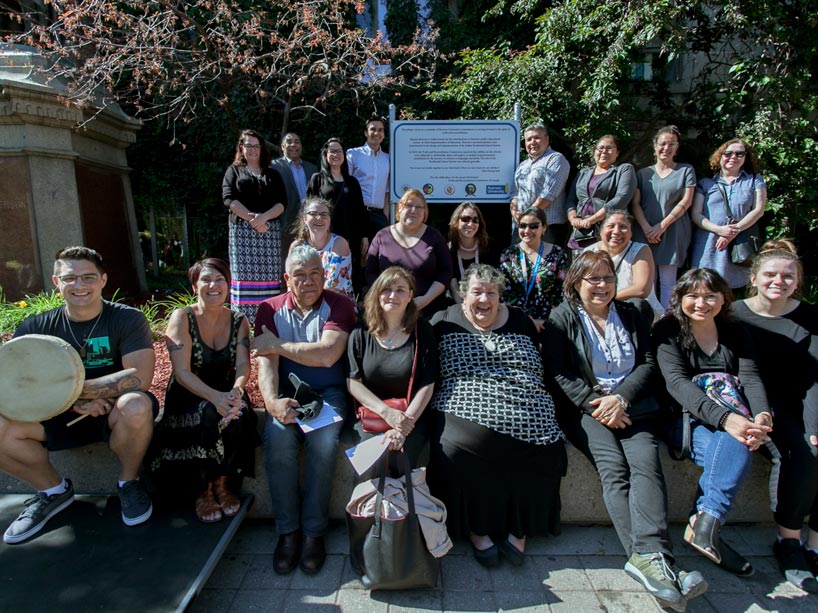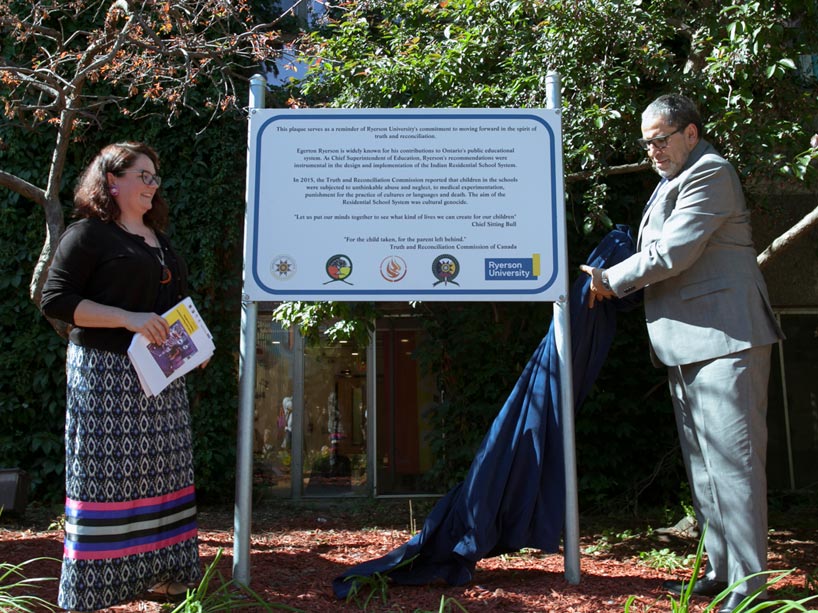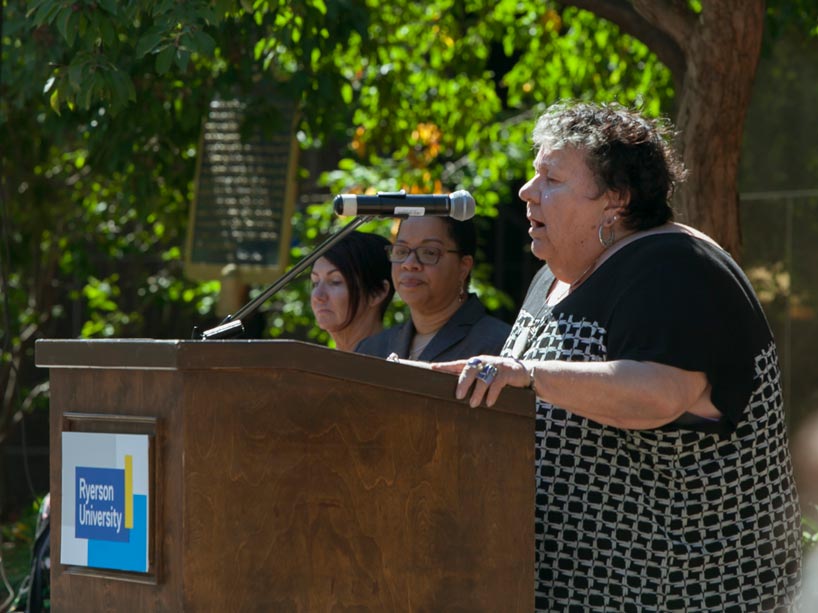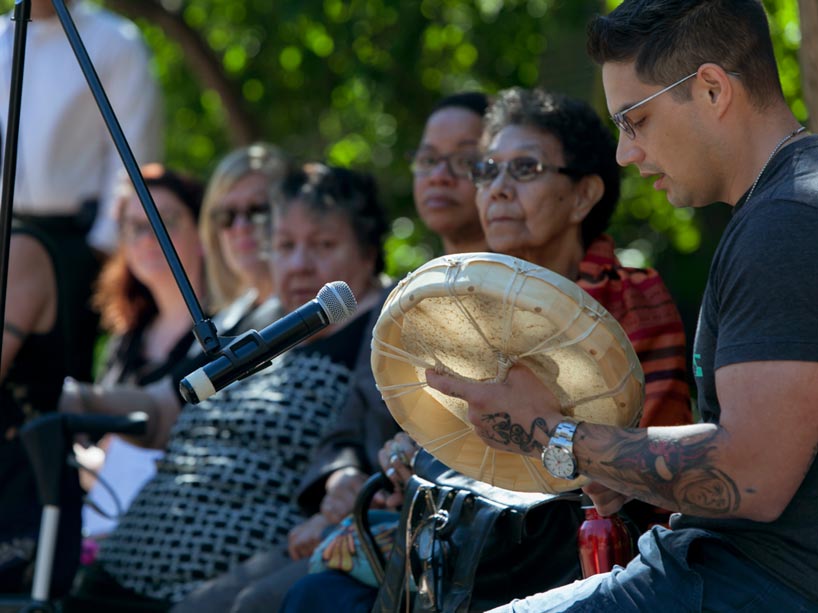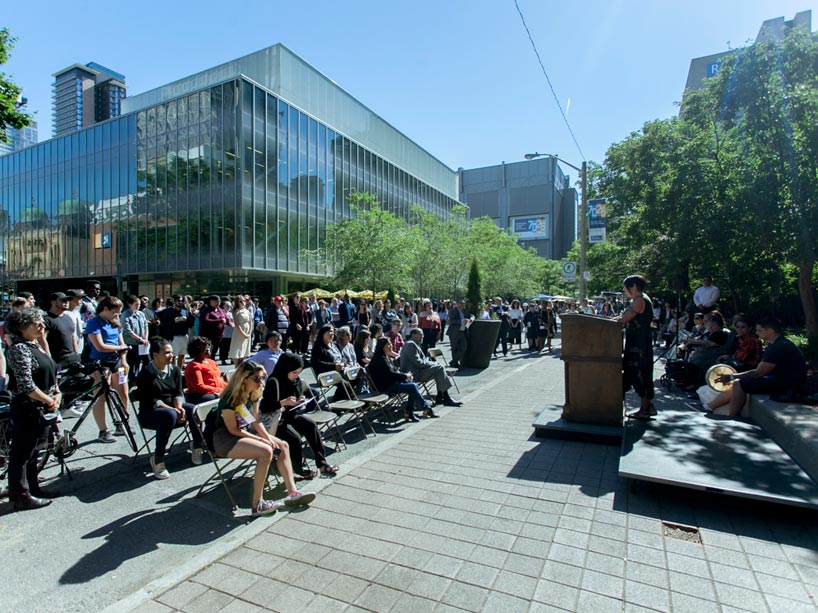Plaque unveiling a step towards truth and reconciliation
Photos: Indigenous students, faculty and staff gathered at the unveiling of a contextualizing plaque at the Egerton Ryerson statue on June 25; Social work student Sarah Dennis and Ryerson President Mohamed Lachemi unveiled the plaque; Elder Joanne Dallaire led a traditional opening (background: Denise O’Neil Green, vice-president, Equity and Community Inclusion; and Cyndy Baskin, chair, Aboriginal Education Council); Social work student Joshua Fisher sang an honour song; The university community gathered on June 25. Photos: Red Works Photography.
The Ryerson community has installed a plaque by the statue of Egerton Ryerson, contextualizing his role in the creation of Canada’s residential school system.
The plaque was one of the recommendations generated from Ryerson’s community consultation report in response to the Truth and Reconciliation Commission of Canada. The university pledged to unveil a plaque “outlining [Egerton] Ryerson’s participation in the establishment of the residential school system in Canada and the harm that was caused by the system that robbed many Indigenous Peoples of their culture and left them with psychological, emotional and physical damage."
The plaque was first unveiled in January 2018. The Aboriginal Education Council, the Office of the Vice-President, Equity and Community Inclusion, and the Ryerson community, including students, were involved in the formal installation at a public event on June 25, held on Gould Street beneath the statue.
The plaque reads:
"This plaque serves as a reminder of Ryerson University's commitment to moving forward in the spirit of truth and reconciliation. Egerton Ryerson is widely known for his contributions to Ontario's public educational system. As Chief Superintendent of Education, Ryerson's recommendations were instrumental in the design and implementation of the Indian Residential School System. In 2015, the Truth and Reconciliation Commission reported that children in the schools were subjected to unthinkable abuse and neglect, to medical experimentation, punishment for the practice of cultures or languages and death. The aim of the Residential School System was cultural genocide."
It concludes with two quotes, one by Chief Sitting Bull (“Let us put our minds together to see what kind of lives we can create for our children”), the other from the Truth and Reconciliation Commission of Canada (“For the child taken, for the parent left behind”).
“Today’s ceremony does not mark a beginning or an end, but is a meaningful and important step in a long journey of reconciliation,” said Ryerson President Mohamed Lachemi. “Egerton Ryerson believed in a different system of education for Indigenous children. These beliefs influenced in part the establishment of what became the Indian Residential School System. We know now and acknowledge the devastating impact that the system has left on First Nations, Métis and Inuit people across our country.”
A 2010 (PDF file) report prepared by the Aboriginal Education Council, notes that an estimated 150,000 Aboriginal children were forced into residential schools across Canada. The Truth and Reconciliation Commission estimates that there are 80,000 survivors and the passing on of unresolved trauma created an intergenerational legacy of the residential school system. Today, Aboriginal survivors, their children, grandchildren and communities are engaged in healing processes to recognize the history and impacts of this educational system on Aboriginal Peoples and support Aboriginal communities in re-claiming their identities.
Lachemi acknowledged the activism of Danielle Sinclair, a Ryerson social work graduate who led a movement to create the plaque. “I still remember a conversation I had with Danielle—she came up with the idea in my office. She could not be here this afternoon, but her passion and influence are felt by us all.”
Denise O’Neil Green, vice-president, equity and community inclusion, said of the plaque, “As we install it now, the words serve as a reminder to all passersby of Ryerson University’s commitment to moving forward in the spirit of truth and reconciliation. And we cannot have reconciliation if we’re not aware of the truth.
“This plaque is also a reminder of our story, our place in history, and evidence of our commitment. It’s a clear signal today that we’re taking just one small step forward in sharing with everyone the truth of our namesake’s legacy.”
Third-year social work student Sarah Dennis (current financial director of the Indigenous Students’ Association (external link) ) spoke of the painful story the statue tells Ryerson’s Indigenous students. “Educational spaces for Indigenous and racialized students are exhausting, to say the least,” she said.
“I’m learning from anti-racism and solidarity through some of the finest educators, staff and students this country has to offer. It’s certainly an improvement from an education centred in brutal acts of cultural genocide, child agricultural and trade labour, and insufficient academic instruction, to say the least. Stolen land, children, starvation and violence is what I see in the way we dress up our spaces.”
Glenn Craney (deputy provost and vice-provost, University Planning) offered an update on Ryerson’s truth and reconciliation pledges, including the formation of a Truth and Reconciliation Commission (TRC) working group chaired by campus Elder Joanne Dallaire, Denise O’Neil Green and Provost Michael Benarroch. Cyndy Baskin, chair of the Aboriginal Education Council, emceed the event, and noted, “This event is not just about Ryerson, but it’s also about the children who attended the residential schools, and their descendants.”
The event also included an honour song by Joshua Fisher (a Ryerson social work student). Dallaire bookended the event with a traditional opening and closing prayer. She ended the event on a cautiously optimistic note: “I put the challenge forth to you that you go tonight and you talk to somebody who doesn’t know about this and educate them. As Senator Sinclair said, ‘It was education that got us into this mess—it’s going to be education that gets us out of it,’ and Ryerson is leading the way.”
For more information on truth and reconciliation at Ryerson, please visit https://www.torontomu.ca/equity/initiatives/truth-reconciliation/.
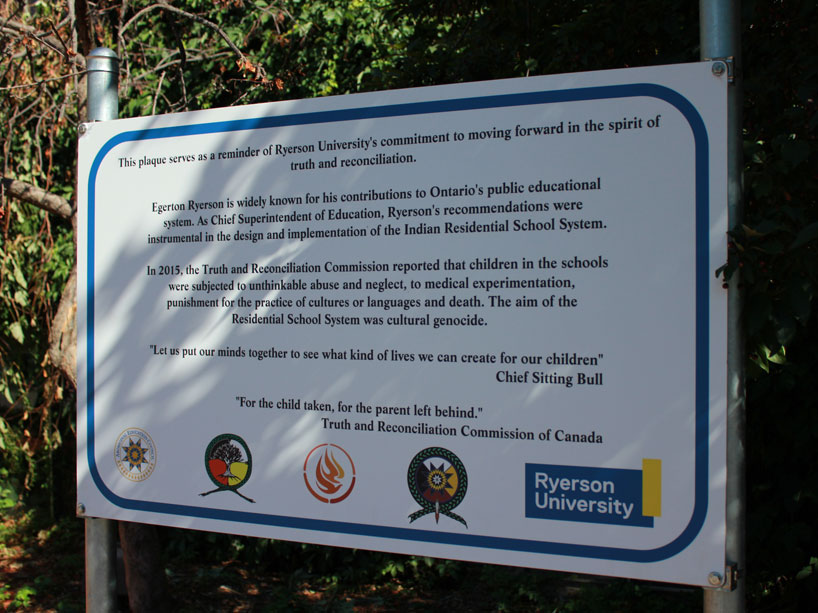
Photo: The plaque, located next to the Egerton Ryerson statue on Gould Street.
